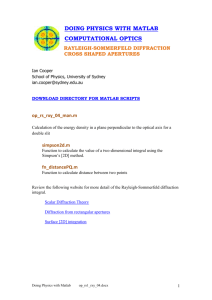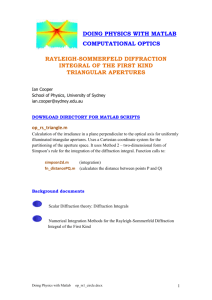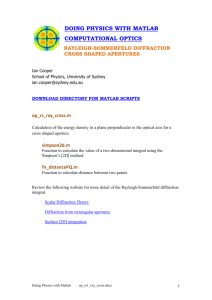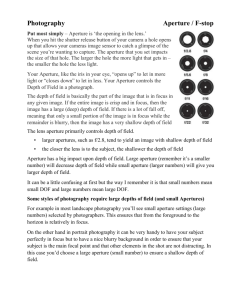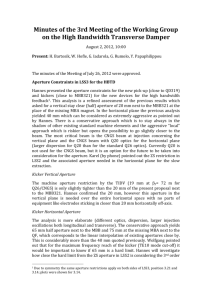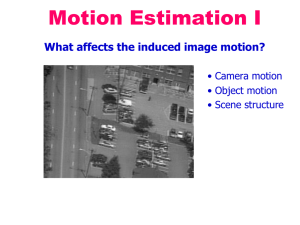op_rs1 - School of Physics
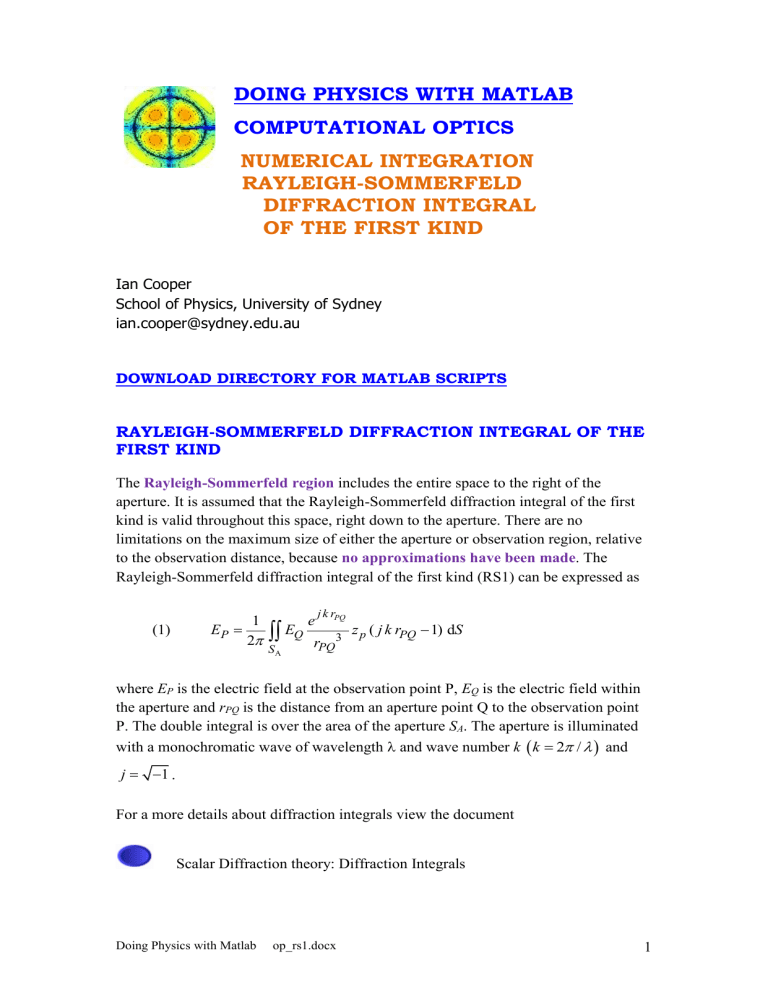
DOING PHYSICS WITH MATLAB
COMPUTATIONAL OPTICS
NUMERICAL INTEGRATION
RAYLEIGH-SOMMERFELD
DIFFRACTION INTEGRAL
OF THE FIRST KIND
Ian Cooper
School of Physics, University of Sydney ian.cooper@sydney.edu.au
DOWNLOAD DIRECTORY FOR MATLAB SCRIPTS
RAYLEIGH-SOMMERFELD DIFFRACTION INTEGRAL OF THE
FIRST KIND
The Rayleigh-Sommerfeld region includes the entire space to the right of the aperture. It is assumed that the Rayleigh-Sommerfeld diffraction integral of the first kind is valid throughout this space, right down to the aperture. There are no limitations on the maximum size of either the aperture or observation region, relative to the observation distance, because no approximations have been made . The
Rayleigh-Sommerfeld diffraction integral of the first kind (RS1) can be expressed as
(1) E
P
1
2
S
A
E
Q e j k r
PQ r
PQ
3 z p
( j k r
PQ
1) d S where E
P
is the electric field at the observation point P, E
Q
is the electric field within the aperture and r
PQ
is the distance from an aperture point Q to the observation point
P. The double integral is over the area of the aperture S
A
. The aperture is illuminated with a monochromatic wave of wavelength
and wave number k
k
and j
1 .
For a more details about diffraction integrals view the document
Scalar Diffraction theory: Diffraction Integrals
Doing Physics with Matlab op_rs1.docx 1
Some of the ways in which Simpson’s rule can be used to compute the value of the electric field E
P
given by equation (1) are discussed below.
1. Two-dimensional form of Simpson’s 1/3 rule using
Simpson’s [2D] coefficients
The double integral given in equation (1) can be estimated numerically by a twodimensional form of Simpson’s 1/3 rule
.
The aperture space is partitioned into a grid of N
N points where N must be an odd number. The electric field E
P
at a point P on an observation screen is approximated by
(2) E
P
E
0
N N m
1 n
1
S E mn Qmn e j k r
PQmn r
PQmn
3 z
Pmn
j k r
PQmn
1
where E
0
is a normalizing constant. Each term in equation (2) can be expressed as a matrix of size N
N and the matrices can be manipulated very easily in Matlab to give the estimate of the integral of equation (1). Then equation (2) is evaluated for each observation point P.
Fig.1. Cartesian and polar grid patterns for the aperture space.
The position of the aperture grid points can be given in Cartesian coordinates or in polar coordinates. For each grid point Q in the aperture, values are specified for:
Cartesian coordinates ( x
Q
, y
Q
, z
Q
) and/or polar coordinates (
Q
,
Q
) z
Q
0 x
Q
Q cos
Q y
Q
sin
Q Q
The coordinates of each point Q are given in a square matrix N
N using the Matlab command meshgrid. The distance r
PQ
between an aperture point Q( x
Q
, y
Q
, z
Q
) and an observation point P( x
P
, y
P
, z
P
) is calculated using the function fn_distancePQ.m
. A square matrix N
N for is constructed for the N
N distances from a point P to the N
N aperture points.
Doing Physics with Matlab op_rs1.docx 2
Electric field E
Q is assumed to be uniform in the aperture and is given by a square matrix N
N .
Simpson’s two-dimensional coefficients
S mn
are given by a square matrix N
N called the Simpson Matrix S . The Simpson matrix S for N = 5 is
1 x 1 = 1 4 x 1 = 4
1 x 4 = 4 4 x 4 = 16
1 x 2 = 8 4 x 2 = 8
1 x 4 = 4 4 x 4 = 16
1 x 1 = 1 4 x 1 = 4
2x1 = 2
2x4 = 4
2x2 = 4
2x4 = 4
2x1 = 2
4x1 = 4
4x4 = 16
4x2= 8
4x4 = 16
4x1 = 4
1x1 = 1
1x4 = 1
1x2 = 1
1x4 = 1
1x1 = 1
The coefficients are calculated using the function simpsonxy_coeff(N).m
where N must be an odd integer .
The irradiance I is proportional to the square of the magnitude of the electric field, hence the irradiance in the space beyond the aperture can be calculated from
(3)
*
I I E E
0 where I
0
is a normalizing constant and E
*
is the complex conjugate of E .
In this calculation, the values of the electric field and irradiance are in arbitrary units.
The irradiance is also known as the intensity or energy density. The term irradiance and the term energy density will often be used interchangeably. The symbol I is inconvenient to use. The symbol u
P
will often be used for the energy density or irradiance ( I
u
P
).
Examples of Matlab mscripts using Method 1
Circular aperture op_rs1_circular_01.m
Rectangular aperture op_rs_rxy_01.m
Doing Physics with Matlab op_rs1.docx 3
2. Two-dimensional form of Simpson’s 1/3 rule
The Rayleigh-Sommerfeld diffraction integral given by equation (1)
(1) E
P
1
2
S
A
E
Q e j k r
PQ r
PQ
3 z p
( j k r
PQ
1) d S can be integrated over the aperture space using either Cartesian or polar coordinates
(4a) E
P
1
2
y y min x max x min
E
Q e j k r
PQ r
PQ
3 z p
j k r
PQ
1
dx dy
(4b) E
P
1
2
min
max min
E
Q e j k r
PQ r
PQ
3 z p
j k r
PQ
1
The integral is estimated numerically using a two-dimensional form of Simpson’s 1/3 rule using the mscript simpson2d.m .
For example, the Matlab statement to calculate the electric field E
P
given by equation
(4a) at a point P which is given specified by the indices ( c1, c2 ) is
EP(c1,c2) = simpson2d(MP,xQmin,xQmax,yQmin,yQmax) ./(2*pi) ; where MP is N
N matrix representing the integrand.
In the first method described above, arbitrary units for electric field and irradiance were used. However, using this second method, SI units can be used all parameters
The irradiance or more generally the term intensity has S.I. units of W.m
-2
. Another way of thinking about the irradiance is to use the term energy density as an alternative. The use of the letter I can be misleading, therefore, we will use the symbol u to represent the irradiance or energy density.
The irradiance or energy density u of a monochromatic light wave in matter is given in terms of its electric field E by
(5) u
c n
0
2
E
2 where n is the refractive index of the medium, c is the speed of light in vacuum and
0 is the permittivity of free space . This formula assumes that the magnetic susceptibility is negligible, i.e.
r
1 where
r is the magnetic permeability of the light transmitting media. This assumption is typically valid in transparent media in the optical frequency range.
Doing Physics with Matlab op_rs1.docx 4
At a point Q in the aperture plane, the energy density is given by the symbol u
Q
and in the observation plane at a point P the symbol used is u
P
. The energy transferred U from the aperture plane to observation plane per second is found by integrating the energy density with respect to an area
(6a) U
[W or J/s]
S u dS
The energy per second radiated from the aperture is
(6b) U
Q
S
Q u dS
Q
integration over the area of the aperture
The energy per second reaching an area S
P
of the observation plane is
(8c) U
P
S
P u dS
P
integration over the area element of the
observation plane
For uniform illumination of the aperture, the energy density is specified first. Then the value of the electric field E
Q
at each grid point is assigned. The aperture shape can be modified by setting certain values of E
Q
to zero, as illustrated in the code for a circular aperture with radius a using a Cartesian grid uQmax = 1e-3; % incident energy density [W.m^-2] cL = 2.99792458e8; % speed of light eps0 = 8.854187e-12; % permittivity of free space nR = 1; % refractive index
EQmax = sqrt(2*uQmax/(cL*nR*eps0));
EQ = EQmax .* ones(nQ,nQ);
EQ(rQ > a) = 0;
Examples of Matlab mscripts using Method 1
Circular aperture op_rs1_xy_circle.m (uses Cartesian coordinates)
Doing Physics with Matlab op_rs1.docx 5
3. One-dimensional form of Simpson’s 1/3 rule
The Rayleigh-Sommerfeld diffraction integral given by equation (1)
(1) E
P
1
2
S
A
E
Q e j k r
PQ r
PQ
3 z p
( j k r
PQ
1) d S can be integrated over the aperture polar coordinates
(4b) E
P
1
2
min
max min
E
Q e j k r
PQ r
PQ
3 z p
j k r
PQ
1
On most occasions it is better to use polar coordinates than Cartesian coordinates because most apertures of interest are circular in shape. For polar coordinates specifying the aperture points Q, Methods 1 and 2 use the polar grid pattern as shown in figure (1). With this pattern, the grid density decreases as the radial distance from the origin increases. To overcome this problem, the aperture can be divided into a set of rings of equal width. Each ring is assigned a set number of grid points and the number of grid points assigned increases as the radius of the rings increase.
Consider the integration of the function f ( x , y ) over a circle
A
circle
The circle is divided into N rings of equal width dr with the c th
ring having n ( c ) gird points.
The integration for each ring is now reduced to a one-dimensional integration. For the c th
ring, the value of the integral is
2
A ring c
r dr
Q
0 f ring d
The total integral A is found by summing the contributions of each ring A ring
A
N c
1
A ( ) ring
The code from the mscript op_rs_circle_rings.m
below gives an example of how
Method 3 can be implemented for a circular aperture.
Doing Physics with Matlab op_rs1.docx 6
% ===================================================================
% Computing the Rayleigh-Sommerfeld 1 Diffraction Integral by Method 3
% EP along the X axis [V/m]
% nP grid points for P
% nR is the number of rings
% n is the number of grid points for a given ring
% uP energy density (irradiance) along the X axis [W/m^2] for cP = 1 : nP for cQ = 1 : nR
t = linspace(0,2*pi,n(cQ));
xQ = r(cQ) .* cos(t);
yQ = r(cQ) .* sin(t);
unit = ones(1,n(cQ));
rPQ = fn_distancePQ(xP(cP),yP,zP,xQ,yQ,zQ);
rPQ3 = rPQ .* rPQ .* rPQ;
kk = ik .* rPQ;
MP1 = exp(kk);
MP1 = MP1 ./ rPQ3;
MP2 = zP .* (ik .* rPQ - unit);
f = EQmax .* MP1 .* MP2;
A(cQ) = r(cQ) * simpson1d(f,0,2*pi); end
EP(cP) = dr * sum(A) / (2*pi); end uP = (cL*nRI*eps0/2) .* abs(EP).^2;
Examples of Matlab mscripts using Method 3
Circular aperture op_rs_circle_rings.m
Doing Physics with Matlab op_rs1.docx 7
